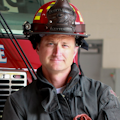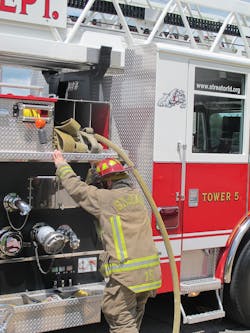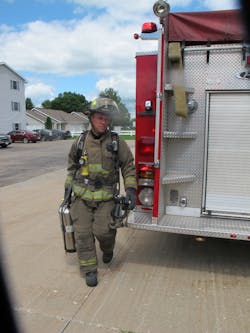Calling the Audible in a Changing Environment
Many refer to firefighters as tactical athletes, particularly when physical fitness is discussed. That said, what about the “playbook”? One could say that standard operating procedures serve as the playbook on a standard incident. What happens when conditions change and tactics must be adjusted? Have company officers trained on calling the audible?
The core of tactical adjustment
Riding assignments and order of arrival documents give firefighters direction when they respond to an incident. However, nothing can replace the solid tactical decisions of an experienced company officer. Furthermore, there are too many variables to write a procedure for every incident and every element that crews face.
After a 360-degree size-up, the company officer should be able to alter the tactics. Once the audible is called, crew members should know the expectations and their position on the fireground.
Professional athletes practice plays over and over to build muscle memory and flawless execution. The same principle applies for crews. They must practice to build muscle memory to be able to react to simple cues by the company officer.
As with any tactical decision at an incident, calling an audible comes down to the officer setting and communicating clear expectations. After all, a quarterback doesn’t tell a wide receiver to merely run down the field and run around and the ball will be thrown to him. Plays have a defined route.
Communication
Of course, effective communications includes delivering verbal instructions, but it also must include nonverbal cues, given the noise that exists on the fireground.
Companies must practice a set of basic hand signals. For example, during master stream operations, sometimes it’s necessary for someone who’s on the ground to communicate to the person who is operating the device regarding fine-tuning the water stream for maximum target placement. This communication can be difficult to do verbally, and it would create unnecessary radio traffic if it was conducted over the radio. Hand signals for moving the nozzle up and down and opening the nozzle to a fog or narrowing to a straight stream greatly enhances the operation. Yes, this is basic, but it must be practiced.
Audibles must communicate the position that each member has on the fireground and the responsibilities, including equipment expectations. Often, the driver/operator is overlooked, left at the pump panel. A well-trained, forward-thinking driver/operator can enhance the efficiency of the entire team greatly.
Have you practiced tactics that are based on changes in staffing? Hockey teams drill for the penalty kill when the other team has the player advantage on a power play. The same holds true in firefighting. Companies must train on tactics when running full strength and when they are shorthanded. The latter must not prevent perfect execution.
Defense vs. offense
As a first-arriving company at a working structure fire, strategy and tactics regard much more than offensive or defensive, interior or exterior. Crews might employ a defensive exterior hit and quickly transition to an interior offensive strategy. Crew members must step off of the apparatus with the play in hand.
During defensive operations, crews have several options in the playbook. Crew members must know their position and responsibilities on each defensive operation. Will they deploy a 2½-inch handline, use a deck gun or use a portable monitor nozzle? Where will they place the device? Is the goal to try to cool the burning structure or to perform exposure protection?
Example: Defensive Play—Deck Gun Operation
• Company officer: Conduct the 360 size-up and direct the master stream.
• Driver (pump panel): Pump the apparatus; secondary task: establish a water supply.
• Firefighter A: On the top of the apparatus to operate the master stream.
• Firefighter B (if available): Establish a water supply.
As with any sport, there are more offensive plays than defensive plays for firefighters. The most common offensive play is to stretch the charged handline to the front door or to the unburned side for entry. The company officer must communicate the entry location. Wind-driven incidents might change tactics to entering from the burned side to reduce the risk of firefighters being trapped.
The company officer must communicate the appropriate initial tactic—for a common hoseline attack, the appropriate size line and the entry point for the line. Is it a charged or dry hoseline stretch? Will a preconnected line reach or must it be extended? Is there a rescue situation for which VEIS is the best practice?
Example: Offensive Play—Extending the Line
• Company officer: Conduct the 360 size-up and estimate the stretch.
• Driver (pump panel): Pump the apparatus; secondary task: establish a water supply. The driver will disconnect the 3-inch supply line and attach it to the appropriate discharge.
• Firefighter A: Deploy the 3-inch supply line from the hosebed to the entry point and place a 3-inch-to-1½-inch on the end of the hose.
• Firefighter B (if available; if not, Firefighter A must complete the task): Deploy the pre-connected 1¾-inch handline and disconnect it from the apparatus. Connect the appropriate amount of hose to the reducer and prepare for entry.
Transitional attack
Recent research proved the effectiveness of a defensive-to-offensive transitional attack. Crews hit it hard from the yard, apply water from the exterior to reduce BTUs and the flashover risk and then transition to an offensive attack. Again, this must be practiced and must be communicated clearly on arrival.
There are two basic options on the transitional attack. The first is to utilize the standard preconnected entry hoseline to apply a dash of water through an open window or a doorway. The second is the blitz attack, during which the master stream is utilized to apply
50 percent of the tank water to overwhelm the fire and the crew
transitions to a hoseline attack. Blitz attacks are very effective on garage fires but also can be effective through an open window or doorway with proper stream placement.
When a situation calls for the application of a master stream through a window or a door, the target is very small. This is a good application for the company officer to use hand signals to communicate to the firefighter who operates the master stream.
Example: Transitional Play—Blitz Operations
• Company officer: Conduct the 360 size-up and direct the master stream.
• Driver (pump panel): Pump the apparatus; secondary task: stretch a handline if the company doesn’t have a fourth firefighter.
• Firefighter A (on the top of the apparatus): Operate the master stream.
• Firefighter B (if available): Stretch the handline to the entry point as communicated by the company officer for an interior attack.
Nothing-showing incidents
Nothing-showing incidents can be the most deceiving. Someone (a passer-by or an occupant) or something (an alarm system) reported that a structure is on fire. The job is to assume that there’s a fire in the structure until proved otherwise.
A wise tactic on a nothing-showing or alarm-sounding incident is to have a member carry a 2½-gallon can. The can is great when a small fire is discovered. It provides a little knockdown while the hoseline is deployed.
Example: Nothing-Showing/Alarm-Sounding Incident
• Company officer: Conduct the 360 size-up, look at the alarm panel to identify the alarm location.
• Driver (pump panel): Position the apparatus for a fire attack; prepare to pump the apparatus.; identify a water supply, standpipe and sprinkler connection locations.
• Firefighter A: Grab the can and make entry with the company officer.
• Firefighter B (if available): Assist the driver in identifying a water supply, standpipe and sprinkler connection; be prepared to stretch a hoseline in the event that a fire is discovered.
All of what’s noted above are simple principles, but it’s amazing the amount of discussion and passion that can go into different strategies. Therefore, you must practice, and practice must entail more than a single walk-through. Tactics must be drilled for mastery. Mastery is completing 90 percent of the objective correctly 90 percent of the time.
Beyond ‘normal’
After discussions on strategy and tactics with members of the crew, the company officer must discuss calling audibles based on order of arrival and the employed tactics of the first-in companies. The actions of the companies that arrive prior to your company’s arrival might require an adjustment in companies’ actions.
Crews must be prepared for the audible on incidents that go beyond bread-and-butter operations (e.g., commercial buildings, apartments, high rises and big box stores). Company officers can take it one step further by discussing plays for hazardous substance releases, carbon monoxide calls, EMS calls, motor vehicle collisions, etc.
One of the most dynamic incident situations are incidents of immediate danger: retreat to safety, structure withdraws and evacuation, and maydays. During a life or death situation isn’t the time for the company officer to be coaching the crew.
When on the interior, communications between crew members must be flawless, simple, verbal commands that elicit immediate response. Crews must be able to take immediate action for
self-preservation. In immediately dangerous situations, members must perform the task to the mastery level instinctively to maximize survival potential.
Challenge the thinking
It always is important to work within the policies and procedures of the organization. Know standard operation manuals for operating at structure fires. Once the manuals are mastered, challenge crews to think of what-if situations and their realistic, appropriate responses.
Develop a robust playbook that includes audibles. Drill on the playbook to make execution of the tactics flawless, which should result in an efficient, positive outcome on the fireground.
Failure to adjust the tactical plan at any given incident can result in cascading events that can result in tragedy.
Good play-calling comes down to effective communications, clear expectations and practice. Professional athletes have the luxury of knowing on any given day whether their work that
day is for practice, a regular season game or the championship. Unfortunately, firefighters don’t have such a luxury when they show up at the firehouse. They better bring their best game
every day that they report for duty.
About the Author

Brian Gettemeier
Brian S. Gettemeier has been in the fire service for 31 years, the past 28 years as a career firefighter with the Cottleville Fire Protection District of St. Charles County, MO, where he serves as an engine company captain. He is a member of St. Louis Metro Urban Search and Rescue Task Force 1. Gettemeier is a second-generation firefighter. He has a bachelor’s degree in fire service management from Southern Illinois University and holds numerous state certifications. Gettemeier teaches all-hazard classes for numerous municipal and industrial organizations throughout the states of Missouri and Illinois. He presented at Firehouse Expo multiple times.


